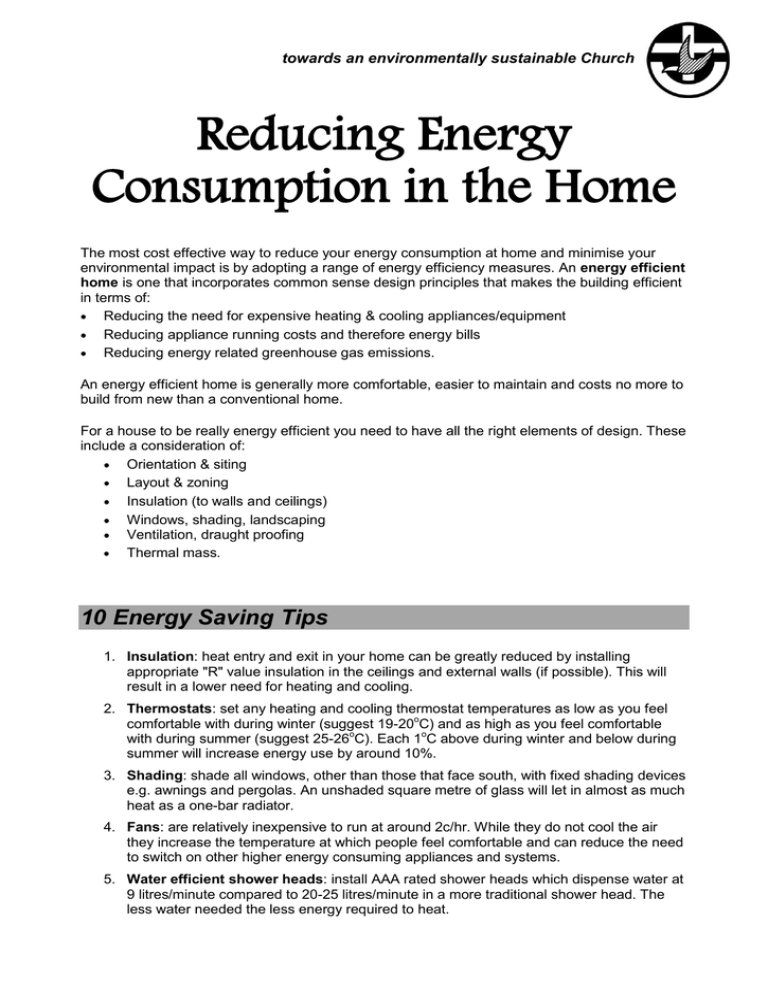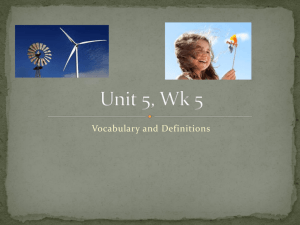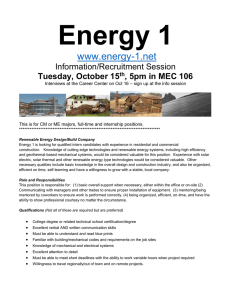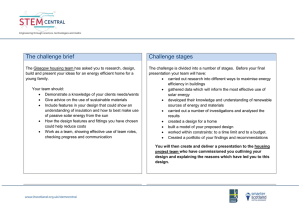Reducing Energy Consumption in the Home
advertisement

towards an environmentally sustainable Church Reducing Energy Consumption in the Home The most cost effective way to reduce your energy consumption at home and minimise your environmental impact is by adopting a range of energy efficiency measures. An energy efficient home is one that incorporates common sense design principles that makes the building efficient in terms of: Reducing the need for expensive heating & cooling appliances/equipment Reducing appliance running costs and therefore energy bills Reducing energy related greenhouse gas emissions. An energy efficient home is generally more comfortable, easier to maintain and costs no more to build from new than a conventional home. For a house to be really energy efficient you need to have all the right elements of design. These include a consideration of: Orientation & siting Layout & zoning Insulation (to walls and ceilings) Windows, shading, landscaping Ventilation, draught proofing Thermal mass. 10 Energy Saving Tips 1. Insulation: heat entry and exit in your home can be greatly reduced by installing appropriate "R" value insulation in the ceilings and external walls (if possible). This will result in a lower need for heating and cooling. 2. Thermostats: set any heating and cooling thermostat temperatures as low as you feel comfortable with during winter (suggest 19-20oC) and as high as you feel comfortable with during summer (suggest 25-26oC). Each 1oC above during winter and below during summer will increase energy use by around 10%. 3. Shading: shade all windows, other than those that face south, with fixed shading devices e.g. awnings and pergolas. An unshaded square metre of glass will let in almost as much heat as a one-bar radiator. 4. Fans: are relatively inexpensive to run at around 2c/hr. While they do not cool the air they increase the temperature at which people feel comfortable and can reduce the need to switch on other higher energy consuming appliances and systems. 5. Water efficient shower heads: install AAA rated shower heads which dispense water at 9 litres/minute compared to 20-25 litres/minute in a more traditional shower head. The less water needed the less energy required to heat. 6. Solar hot water: consider installing a solar hot water system. If you live in Adelaide the sun can contribute 60-70% of your hot water. This will significantly reduce the need to heat water using electricity or gas. 7. Refrigerators: try and get by with only one fridge/freezer. If you have a second fridge and/or freezer only turn it on when required, or better still dispose of it. 8. Fluorescent and LED lighting: replace ordinary incandescent (tungsten filament) lighting in frequently lit rooms with fluorescent lighting, either tubes or compact fluorescent globes. This lighting uses approx one fifth the energy of incandescent globes and can last up to 10 times longer. Compact fluorescent globes are available at most supermarkets. If you have halogen lamps consider replacing them with LED equivalents which use much less power and give off much less heat for the same light output. 9. Standby power: this is energy used by an appliance/item while plugged in but not performing its primary function e.g. the red standby light on your TV/VCR. If an appliance has a standby mode, where and when appropriate switch off these appliances at the power point when not in use or when you are going away for a few days or more. You can borrow an energy meter from your local library (as part of a Home Energy Toolkit) to see which appliances use power when they are switched on at the wall even when the device itself is switched off. 10. Energy (Star) Ratings: where applicable use appliance Energy (Star) Ratings to select energy efficient appliances. The more stars the more efficient. See the Energy Smart section of www.sa.gov.au/energysmart for more details on these and other energy saving measures you can adopt in your home. Residential Energy Efficiency Scheme The South Australian Government introduced the Residential Energy Efficiency Scheme (REES) from 1 January 2009 to help households “be energy smart”. Under REES, providers of electricity and gas in South Australia are required to meet targets which are about improving the energy efficiency of our homes. In order to fulfil their targets, providers are offering households incentives to adopt energy saving measures; things like insulation and more efficient lighting. This in turn helps households reduce their energy bills, as well as minimise their impact on the environment by reducing greenhouse gas emissions. It will also help households get prepared for energy cost increases that are likely to follow from the Federal Government‟s Carbon Pollution Reduction Scheme. The REES is intended to benefit all types of households, but has a particular focus on low income families who are most vulnerable to rising energy costs. A third of the targets must be met in low income households. Households are able to take up special offers and incentives from any electricity or gas provider, not just the one currently supplying them. It is up to each energy provider to determine what measures and incentives they offer to households. These may include rebates or other special offers to: Install ceiling insulation Use more efficient lighting and showerheads Draught proof doors and windows Install more efficient appliances such as water heaters and heating and cooling systems Retire second fridges and freezers. The following providers are obliged to provide these services in 2009:- AGL, Origin Energy, TRUenergy, Simply Energy, SA Electricity, Red Energy and Powerdirect. Contact them directly for details of their incentive programs. For more information about REES see www.sa.gov.au/energysmart or phone the government‟s Energy Advisory Line on (08) 8204 1888. Ceiling Insulation The Federal Government announced in February 2009 that it intends to provide free ceiling insulation in homes that don‟t already have insulation. Eligible applicants are able to seek reimbursement up to a maximum amount of $1,600 if they install ceiling insulation from 3 February 2009. The program formally runs from 1 July 2009 to 31 December 2011. This new initiative was announced in parallel to increased solar hot water rebates – see below. Householders will only be able to access the insulation or solar hot water rebate, not both. See www.environment.gov.au/energyefficiency for more details. Alternative Forms of Energy Supply In addition to adopting energy efficiency measures in your home, the other main way to reduce the environmental impact of the energy you consume at home is to use renewable energy where possible. The simplest and most cost effective way to do this is to install a solar hot water service. Using energy from the sun to heat your water is much more environmentally friendly than using electricity to heat your water and the pay back period for the extra investment may only be a few years when various rebates are taken into account. The South Australian Government's Solar Hot Water Rebate Scheme provides a rebate of $500 on the cost of a new solar or electric heat pump water heater for low income households. The Rebate Scheme is targeted at low income households to help them comply with new performance standards for hot water heaters effective from July 2008. See www.energy.sa.gov.au/shw for more details. Many home owners replacing a conventional electric storage hot water system may be eligible for a $1,600 rebate under the revised Australian Government‟s solar hot water rebate scheme announced in February 2009. See www.environment.gov.au/solarhotwater for more details. Furthermore, most householders who are upgrading from a conventional electric storage water heater to a solar or electric heat pump system will be eligible for Renewable Energy Certificates (RECs) under the Australian Government mandatory renewable energy target. Eligibility for RECs should be assessed via the proposed system vendor, or equipment manufacturer, prior to installation. The program is administered by the Office of the Renewable Energy Regulator. See www.orer.gov.au for more details. The next most effective way to utilise renewable energy in your home is to purchase GreenPower from your energy retailer. When you buy GreenPower, your electricity retailer ensures that the same amount of environmentally friendly, renewable energy is supplied into the electricity network. GreenPower gives you the choice to support electricity generation from clean, renewable energy sources, including solar, wind, biomass, and hydro power. The National GreenPower Accreditation Program run by all the States and Territories plus the Commonwealth, set the rules for GreenPower products and audits accredited electricity generators and retailers. Only renewable energy products that display the GreenPower logo are government accredited. See www.greenpower.gov.au for more details. The other alternative is to invest in some form of renewable energy generation plant on your property. Broadly speaking, renewable energy includes sources of power that are replaceable or non-depletable within a reasonable time frame. Sources of power such as solar, wind, biomass, geothermal and hydropower are usually classified as renewable. When we talk about solar energy we usually mean the light or heat energy that reaches us directly from the sun. There are two main categories - solar thermal and solar electric: Solar thermal systems - heat energy can be captured and used directly or stored. The most obvious example of stored solar heat is the familiar domestic solar hot water service. Solar electric systems - these produce electricity directly from photovoltaic (often called PV) cells. When light energy falls on the cell, some electrons in the cell absorb sufficient energy to break away from their atoms and establish a current flow. An obvious limitation of solar systems is that some means of storing the energy or an alternative supply is required to ensure power is available 24 hours per day. The most common means of achieving this is to draw power from the electricity grid when the sun is not shining. For those interested in the details on relative costs, they can be broadly summarised as follows: Solar hot water – for those receiving the Federal $1,600 rebate and Renewable Energy Certificates, the additional net cost for an electric boosted solar system (compared to a conventional electric storage system) is only about $300. Lower operating costs would offset this additional cost within 2 years. The additional cost of purchasing 100% GreenPower is about 5-6 cents per kWh above the price you might pay for „black‟ energy. The cost for purchasing the same amount of carbon offsets is comparable. For solar photovoltaic cells, assuming you are eligible for around $5,000 credit under the solar credits scheme that came into effect in July 2009, the net cost might be around $7,000 for a 1 kW installation. You will receive between 44c and 50c per kWh (depending on your electricity retailer) for the power you put into the grid above what you use in your house. The $7,000 investment might be paid back by this income in about 15 years assuming a 7% interest cost and half of the energy you generate is put back into the grid and sold at 50 cents/kWh. Links to Related Web Sites See the South Australian Government site www.dtei.sa.gov.au/energy/renewable_energy for more details on various types of renewable energy. See the Federal Government site www.environment.gov.au/settlements/energyefficiency/index.html for more details of energy efficiency measures suitable for homes plus further details on rebates and renewable energy options. See the Federal Department of Climate Change site www.climatechange.gov.au for more details about Government policy related to a range of climate change issues. Written on behalf of the Church Environment Working Group This document can be found on the Uniting Church SA website at http://resources.sa.uca.org.au/environment Uniting Church SA … towards an environmentally sustainable Church Uniting Church SA Uniting Church in Australia Presbytery and Synod of South Australia Level 2, 212 Pirie St, GPO Box 2145, Adelaide SA 5001 Ph: 08 8227 0822 Ph: (country callers free call) 1300 766 956 www.sa.uca.org.au we seek to be an innovative, growing church proclaiming Jesus Christ, empowered by the Spirit to transform God's world.



